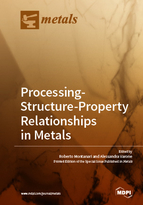Processing-Structure-Property Relationships in Metals
A special issue of Metals (ISSN 2075-4701). This special issue belongs to the section "Metal Casting, Forming and Heat Treatment".
Deadline for manuscript submissions: closed (20 March 2019) | Viewed by 78968
Special Issue Editors
Interests: surface treatments, coatings, mechanical properties, XPS, AES, LDH
Special Issues, Collections and Topics in MDPI journals
Interests: materials characterizations; X-ray diffraction; scanning electron microscopy
Special Issues, Collections and Topics in MDPI journals
Special Issue Information
Dear Colleagues,
In the industrial manufacturing of metals, the achievement of products featuring desired characteristics always requires the control of process parameters in order to get a suitable microstructure. The strict relationship among process parameters, microstructure, and mechanical properties is a matter of interest in different areas, such as foundry, plastic forming, sintering, welding, etc., and regards both well-established and innovative processes.
Nowadays, circular economy and sustainable technological development are dominant paradigms and impose an optimized use of resources, a lower energetic impact of industrial processes and new tasks for materials and products. In this frame, this Special Issue covers a broad range of research works and will contain research and review papers. Particular attention is paid to novel processes and recent advancements in testing methods and computational simulations able to characterize and describe microstructural features and mechanical properties.
We do hope the Special Issue of Metals will gather manuscripts from academic and industrial researchers, will lead to fruitful international networking and cooperation, as well as stimulating new ideas and investigations.
Prof. Dr. Roberto MontanariDr. Alessandra Varone
Guest Editors
Manuscript Submission Information
Manuscripts should be submitted online at www.mdpi.com by registering and logging in to this website. Once you are registered, click here to go to the submission form. Manuscripts can be submitted until the deadline. All submissions that pass pre-check are peer-reviewed. Accepted papers will be published continuously in the journal (as soon as accepted) and will be listed together on the special issue website. Research articles, review articles as well as short communications are invited. For planned papers, a title and short abstract (about 100 words) can be sent to the Editorial Office for announcement on this website.
Submitted manuscripts should not have been published previously, nor be under consideration for publication elsewhere (except conference proceedings papers). All manuscripts are thoroughly refereed through a single-blind peer-review process. A guide for authors and other relevant information for submission of manuscripts is available on the Instructions for Authors page. Metals is an international peer-reviewed open access monthly journal published by MDPI.
Please visit the Instructions for Authors page before submitting a manuscript. The Article Processing Charge (APC) for publication in this open access journal is 2600 CHF (Swiss Francs). Submitted papers should be well formatted and use good English. Authors may use MDPI's English editing service prior to publication or during author revisions.
Keywords
- Industrial processes
- Process parameters
- Microstructure
- Mechanical properties
- Testing methods
- Simulation







